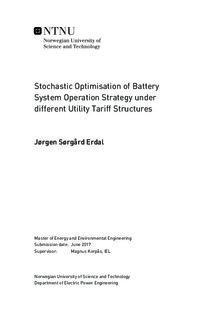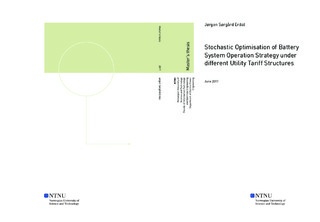| dc.description.abstract | This master thesis develops a stochastic optimisation software for household grid-connected batteries combined with PV-systems. The objective of the optimisation is to operate the battery system in order to minimise the costs of the consumer, and it was implemented in MATLAB using a self-written stochastic dynamic programming algorithm. Load was considered as a stochastic variable and modelled as a Markov Chain. Transition probabilities between time steps were calculated using historic load patterns from up to three previous years, exploiting the repetitive patterns of weekdays and weekends. PV-production was considered deterministic when included. The SDP-model was tested on data from Norwegian households for 2016, and the global optimum solution was used as a benchmark, as found using the dynamic programming model from the project work.
As Norwegian households were used as test cases, the Nordic power market Nord Pool Spot sat the scene for market transaction calculations. Day-ahead spot prices were used as market prices, meaning that the prices for the coming day was considered deterministic from noon the present day. The fixed 24-hour horizon optimisation was performed at midnight for each day, yielding an optimal wait-and-see operational policy for the battery system.
The optimisation was investigated under three different utility tariff (UT) structures: Energy based, time based and power based. The energy based UT is a fixed price per kWh, which is what is being used in today's market. The time based UT is a time-of-use tariff, which penalised use during peak demand hours 9-11 and 17-19 in weekdays. The power based UT increases linearly with the demand, designed to limit the power usage at any given time and day. While the energy based UT is what is being used as of today, the widespread roll-out of advanced metering systems (AMS) by 2019 in the Norwegian market will enable UT structures such as the time- and power based ones studied in this thesis.
The global optimal solution achieved 1.2 % (energy based UT), 14.2 % (time based UT) and 8.6 % (power based UT) of operational savings without a PV-system, illustrating the negligible potential for saving under the energy based UT. The developed SDP-model achieved 75-92 and 87-94 % of the global optimal savings without a PV-system under the energy- and time based utility tariff, respectively. This is increased to 92-99 % and 91-96 % with the PV-system installed. Under the power based utility tariff the model shows less promising results, scoring a maximum of 25-44 % of the global optimal solution without a PV-system, and 75-90 % with. | |

